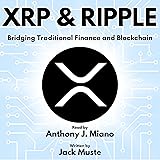Unlocking the Crypto Revolution: A Comprehensive Guide for Beginner Investors
Imagine being at the cusp of a financial transformation so profound it rivals the birth of the internet or the industrial revolution itself. Such moments are rare, often appearing once in a generation, presenting unparalleled opportunities for wealth accumulation. Just as early investors in the S&P 500 saw modest sums blossom into millions, a similar, perhaps even greater, potential now resides within the burgeoning world of cryptocurrency.
The accompanying video provides an excellent introduction to this exciting domain, detailing the fundamental principles and practical steps necessary for anyone looking to invest in crypto as a beginner. It is a simplified lesson, distilling years of experience into accessible insights. This article builds upon those foundations, expanding on key concepts and offering deeper context to help you navigate this revolutionary market with confidence and foresight.
Understanding the Crypto Basics: A New Financial Paradigm
At its core, cryptocurrency represents a fundamental shift in how value is exchanged and stored. This innovation stems from cryptography, the science of secure communication, which enables data encryption for transactional ledgers. Information can be transmitted seamlessly and securely between parties, forming the backbone of digital assets. Unlike traditional financial systems, which depend on centralized institutions, blockchain technology operates on a distributed network, validated by numerous participants rather than a single entity.
Several major use cases underscore the profound importance of cryptocurrency in today’s evolving financial landscape. Firstly, crypto serves as a powerful store of value. Bitcoin, for example, possesses a finite supply of 21 million tokens, mimicking the scarcity of precious metals like gold. This contrasts sharply with fiat currencies, such as the U.S. dollar, whose value steadily degrades due to continuous printing by central banks like the Federal Reserve. Over the past five years alone, the dollar has experienced a nearly 19% loss in purchasing power, a trend that intensifies over longer periods.
Secondly, Decentralized Finance (DeFi) represents a crucial application. This ecosystem allows for programmable money, where automated systems can distribute funds and validate transactions without human intermediaries. Imagine financial services—lending, borrowing, insurance, asset management—executed with unprecedented speed, accuracy, and accountability, all powered by a network of validators. This represents a significant step towards a more efficient and transparent global financial infrastructure, poised to integrate into existing systems over time.
Thirdly, stablecoins offer a bridge between the volatile world of crypto and the stability of traditional assets. These cryptocurrencies are designed to mirror the value of stable assets, such as the U.S. dollar or Japanese Yen. For instance, USDT and USDC are prominent stablecoins, each representing a one-to-one value equivalent of the dollar. This allows users to engage in blockchain-based trading and transactions while mitigating the price fluctuations common to other cryptocurrencies. Beyond these primary applications, blockchain technology is actively exploring uses across diverse sectors, including global payments, supply chain management, healthcare, and intellectual property, signaling a future where transparency and decentralization are paramount.
Navigating the Crypto Landscape: Essential Terminology for Beginners
To effectively participate in this market, familiarity with key crypto terms is essential. These concepts form the bedrock of understanding how digital assets function and interact within their respective ecosystems.
-
Private Key / Seed Phrase: This is a highly sensitive string of words or characters that grants access to your cryptocurrency wallet. It functions as the ultimate password, controlling your digital assets directly. Sharing it with anyone compromises your entire holdings. “Not your keys, not your crypto” is a fundamental mantra in the community, emphasizing self-custody.
-
Centralized Exchanges (CEX): Platforms like Coinbase allow users to easily buy, sell, and trade cryptocurrencies using fiat money (e.g., USD). While convenient and user-friendly, CEXs retain control of your private keys, meaning they technically hold your crypto on your behalf, subject to their terms and conditions. Recovery options are typically available through customer support.
-
Decentralized Exchanges (DEX): These peer-to-peer marketplaces facilitate direct trading of cryptocurrencies on the blockchain. Users maintain full control over their private keys, enhancing security. However, this comes with the responsibility of safeguarding your seed phrase, as there are no recovery options if it is lost.
-
Tokenomics: This term refers to the economic principles governing a cryptocurrency token. It encompasses how tokens are created, distributed, managed, and used within a project’s ecosystem. Understanding coin allocations, vesting schedules, and inflation mechanisms is crucial for evaluating a project’s long-term viability.
-
Market Capitalization (Market Cap): Calculated by multiplying the current price of a token by its circulating supply, market cap indicates the total value of a cryptocurrency project. It is a key metric for gauging a project’s size and relative risk. Large-cap cryptocurrencies (over $10 billion) are generally considered more stable, while mid-cap ($1-10 billion), small-cap ($100 million-$1 billion), and micro-cap (under $100 million) projects offer higher growth potential but come with increased risk.
-
Circulating Supply, Total Supply, and Max Supply: Circulating supply refers to the number of tokens publicly available and trading. Total supply is the total number of tokens created, whether in circulation or not. Max supply is the absolute maximum number of tokens that will ever exist. Understanding these distinctions is vital for assessing a project’s potential for dilution.
-
Fully Diluted Valuation (FDV): This metric calculates a project’s market cap if all its tokens (total supply) were in circulation at the current price. A significant gap between market cap and FDV can indicate a higher risk of dilution when additional tokens are released into the market, potentially impacting token value.
-
Trend (Uptrend/Downtrend): In technical analysis, an uptrend is characterized by a sequence of higher highs and higher lows, signaling bullish sentiment. Conversely, a downtrend features lower highs and lower lows, indicating bearish momentum.
-
Altcoin: A portmanteau for “alternative coin,” this term broadly refers to any cryptocurrency other than Bitcoin. Many altcoins represent smaller, more speculative projects, but some, like Ethereum, have substantial market caps and distinct use cases.
-
Smart Contracts: These self-executing contracts are stored and run on a blockchain. They automatically enforce the terms of an agreement when predefined conditions are met, facilitating trustless and automated transactions without intermediaries. This technology underpins much of the DeFi ecosystem.
-
Gas Fees: These are the transaction fees paid on blockchain networks (e.g., Ethereum, Solana) to execute operations. Gas fees are typically paid in the native token of the respective blockchain and compensate validators for processing and securing transactions.
Beyond these technical definitions, the crypto community also employs a unique lexicon. “HODL” (Hold On for Dear Life) refers to holding assets despite market volatility. “FOMO” (Fear Of Missing Out) describes impulsive buying driven by rising prices. “FUD” (Fear, Uncertainty, Doubt) denotes negative rumors or sentiment. A “whale” is a large investor, while a “rug pull” signifies a scam where project founders abandon it, taking investors’ funds. “Degen” (degenerate) refers to risky, speculative trading, and “aping” means impulsively investing heavily into a project.
Equipping Your Crypto Arsenal: Essential Tools for Investors
Navigating the practicalities of beginner crypto investing requires a foundational set of tools for buying, selling, organizing, and interacting with the market. Establishing a clear process for moving funds into and out of crypto is paramount for tracking profitability and managing taxes.
The initial step often involves a fiat on-ramp. Centralized exchanges like Coinbase are widely used for this purpose, as they seamlessly connect to traditional bank accounts. This integration allows for straightforward deposits and withdrawals of fiat currency, which can then be converted into cryptocurrencies. Having a primary centralized exchange for this function helps consolidate financial records.
For active trading and short-term holdings, a combination of decentralized wallets is typically employed. Metamask and Phantom are popular choices, functioning as browser extensions that connect to various blockchain applications. Phantom is specifically favored for managing Solana-based tokens, while Metamask supports a broader range of Ethereum Virtual Machine (EVM) compatible chains. These wallets empower users with direct control over their private keys, enabling seamless interaction with decentralized applications (dApps) and peer-to-peer trading.
However, for long-term strategic holdings, especially assets like Bitcoin, cold storage wallets, such as a Ledger device, are highly recommended. These hardware wallets store your private keys offline, significantly reducing the risk of cyber theft. While the physical device itself does not store your crypto, it safeguards the cryptographic keys that unlock your on-chain assets. In the event of device loss, access to your assets can be restored using your seed phrase, provided it has been securely backed up. This method offers the highest level of security for significant, long-term investments, keeping assets isolated from online vulnerabilities.
For those engaging in short-term profit-taking or leveraging opportunities, platforms like Bybit or BloFin are specialized day trading exchanges. These platforms offer advanced trading features, including leverage, which allows traders to control larger positions with a smaller capital outlay. It is important to exercise caution with such tools, as leverage magnifies both potential gains and losses. Due to varying regulations and security concerns, significant balances are often not maintained on these accounts for extended periods.
Finally, robust research and analysis tools are indispensable. CoinMarketCap serves as a comprehensive hub for initial project research, offering quick access to market caps, trading volumes, charts, and official project links. For deeper on-chain metrics—data directly from the blockchain—platforms like Glassnode offer advanced insights into network activity and investor behavior. A free alternative, CoinGlass, provides similar metrics. TradingView is the industry standard for technical analysis, providing charting tools to identify trends, patterns, and potential entry/exit points.
Mastering Fundamental and Technical Analysis for Crypto Success
Effective crypto investing necessitates a blend of fundamental and technical analysis, allowing investors to make informed decisions and manage risk. Understanding how money is actually made from investing—buying low and selling high—is fundamental. Success hinges on a clear risk management strategy, differentiating between stop-loss risk (predefined exit for a contained loss) and liquidation risk (holding until an asset approaches zero value, often used for long-term conviction plays).
For long-term investors, the concept of position sizing is critical. This involves determining the appropriate amount of capital to allocate to a trade or investment based on a predefined risk tolerance. Regardless of leverage used, the distance from entry to stop-loss, multiplied by the number of units, quantifies the exact dollar amount at risk. Tools like the Inevitable Position Size Calculator can automate this, helping to manage exposure effectively.
Fundamental Analysis: Timing the Market Cycles
Bitcoin’s market movements are significantly influenced by its unique four-year halving cycles. Approximately every four years, the reward for mining new Bitcoin is cut in half, creating a supply shock that historically precedes major price surges. Data suggests that approximately 532 days after each halving event, the market often reaches its all-time high. This cyclical nature provides a framework for timing entries and exits, avoiding emotional responses to short-term market fluctuations.
Advanced indicators, such as the Bitcoin Power Law Corridor (developed by CapriCole Investments), help visualize Bitcoin’s long-term logarithmic growth path. This tool highlights historical cycle lows, which often touch the lower green band, and potential highs within the red zone. Similarly, the Bitcoin Terminal Price indicator, a complex equation used by financial firms, suggests a minimum target for Bitcoin’s price before a cycle concludes, indicating potential price points of $165,000-$175,000 in the current cycle. These tools provide a macro perspective, guiding investment decisions based on historical patterns rather than daily news. For instance, Solana’s resurgence was anticipated by some through fundamental understanding of its utility despite its entanglement with FTX, demonstrating the power of discerning underlying value.
Furthermore, on-chain metrics offer invaluable insights. The MVRV (Market Value to Realized Value) ratio, specifically for long-term holders (those holding for over 155 days), often indicates market tops and bottoms. When this ratio enters a specific “green band,” it has historically signaled ideal buying opportunities, while a “red band” suggests market saturation and a potential top. These metrics allow for a more data-driven approach, reducing reliance on speculative sentiment.
Technical Analysis: Decoding Price Movements
Technical analysis involves studying price charts to predict future movements. Key elements include:
-
Trend Lines: These lines connect a series of price highs or lows, indicating the general direction of a market. An uptrend line connects rising lows, while a downtrend line connects falling highs. Breaks of these trend lines often signal a change in market direction.
-
Elliott Wave Theory: This psychological theory posits that market trends tend to move in predictable five-wave impulses, followed by a three-wave (A-B-C) correction. Identifying these wave structures can help project the potential extent of a trend and subsequent retracements.
-
Fibonacci Retracement and Extension: Based on naturally occurring ratios, Fibonacci tools are used to identify potential support and resistance levels. Fibonacci retracement levels (e.g., 0.618) often mark areas where prices might rebound during a correction. Fibonacci extension levels (e.g., 1.618, 2.618) can project potential price targets during an impulsive trend, often aligning with Elliott Wave projections. For example, a common target after an initial impulse is the 1.618 or 2.618 extension.
By combining these analytical techniques, investors are better positioned to understand market dynamics, anticipate significant moves, and manage their capital effectively.
Diversifying Your Crypto Income Streams
The cryptocurrency market offers several avenues for generating wealth, each with its own risk profile and time horizon. Diversifying across these strategies can optimize returns while mitigating potential downsides.
Long-term investing involves allocating capital to cryptocurrencies with strong fundamental use cases and holding them across multiple market cycles. This approach leverages the long-term growth potential of the asset class, aiming for significant returns over several years, often with specific targets set in alignment with Bitcoin’s halving cycles. For example, some investors plan to hold Bitcoin for 20-30 years, anticipating exponential growth. A diversified portfolio often includes a mix of low-risk large-caps (like Bitcoin and Ethereum), mid-risk projects with strong ecosystems, and a smaller allocation to high-risk, high-reward micro-caps.
Swing trading focuses on capturing profits from short-to-medium-term price movements, typically holding assets for weeks or a few months. This strategy involves identifying trends and entering positions based on technical analysis, then selling once a predefined profit target is met. While effective for scaling smaller portfolios, swing trading within the same tax year can incur short-term capital gains taxes, which are often higher than long-term rates. An example would be buying a promising altcoin like Dogecoin at 4 cents and selling it for a nearly 10x return within months during a bull run, then reallocating the profits.
Day trading represents a more active strategy, involving opening and closing positions within a single trading day to profit from intraday price fluctuations. This method is often employed with leverage to maximize returns on small price movements. Day trading can provide a consistent income stream regardless of the broader market direction, but it requires disciplined risk management, advanced technical analysis skills, and robust position sizing. Experienced day traders can generate substantial daily profits, which can then be reinvested into longer-term holdings or used as supplementary income. The key to success in day trading is not about hitting one lucky trade, but consistently executing well-defined strategies with strict risk control.
Adopting a patient and analytical approach to invest in crypto as a beginner can truly set you apart. By understanding the underlying technology, mastering essential terminology, utilizing appropriate tools, and applying both fundamental and technical analysis, individuals are empowered to transform small initial investments into significant wealth. This comprehensive guide aims to provide a solid foundation for those ready to embark on this journey, positioning them to navigate the complexities and capitalize on the immense opportunities within the crypto market.







